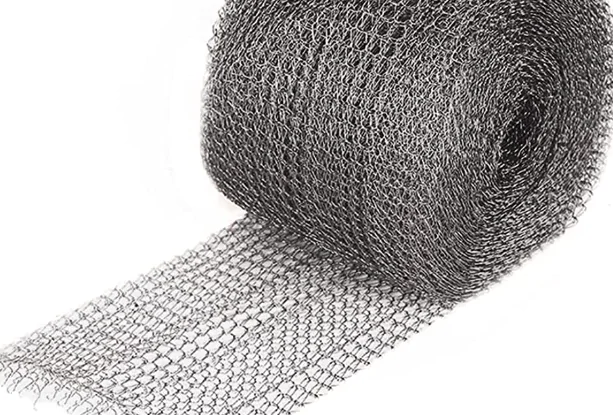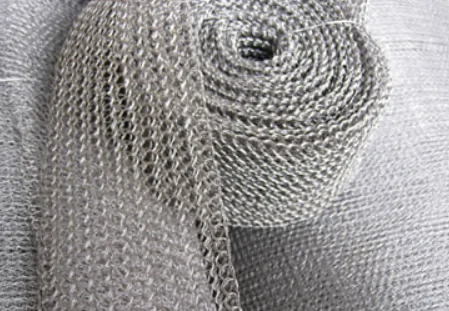Introduction
This article will introduce to you knitted wire mesh, a highly versatile and widely used material in various industries. Did you know that knitted wire mesh is highly resistant to corrosion and rust, making it ideal for use in harsh industrial environments?
If you want to know more about the benefits and applications of knitted wire mesh, keep reading. We will discuss the common types of knitted wire mesh, their benefits, and their applications in more detail.
1. What is knitted wire mesh

Knitted wire mesh is a type of metal wire mesh that is made through a specialized knitting process. The knitting process involves the interlocking of metal wires to create a mesh structure with a uniform and consistent pattern.
The wire is looped around a series of needles and interlocked with adjacent wires, creating a strong and flexible mesh structure. Knitted wire mesh can be made from a wide range of metal materials, including stainless steel, copper, aluminum, and other alloys.
The unique structure of knitted wire mesh makes it highly versatile and suitable for a wide range of applications. Its flexibility and ability to conform to irregular shapes make it an ideal material for use in various industrial applications, including filtration, separation, and gas diffusion.
Its high tensile strength and durability make it well-suited for use in high-stress applications such as the aerospace and automotive industries.
One of the primary benefits of knitted wire mesh is its high porosity. The mesh structure allows for a significant amount of open space, enabling fluids and gases to flow freely through the material. This makes it an ideal material for use in filtration applications, where it can effectively capture particles and debris while allowing for continuous fluid flow.
Additionally, the mesh structure can be tailored to achieve specific levels of filtration, making it highly customizable to meet the needs of various applications.
Another benefit of knitted wire mesh is its ability to withstand extreme temperatures and corrosive environments. The metal materials used in its construction are highly resistant to heat, chemicals, and corrosion, making it suitable for use in harsh industrial environments.
2. Common types of knitted wire mesh

Stainless Steel Knitted Wire Mesh
Stainless steel knitted wire mesh is a remarkable material that has been used extensively in a variety of industrial applications. Its popularity stems from the fact that this type of knitted wire mesh is made from high-quality stainless steel wire, which is incredibly strong, durable, and corrosion-resistant.
These characteristics make stainless steel knitted wire mesh ideal for filtration, separation, gas diffusion, and many other industrial processes. What is worth noting is that this type of wire mesh is designed to withstand the toughest conditions and perform effectively for long periods.
Copper Knitted Wire Mesh
Copper-knitted wire mesh is a reliable solution for those searching for high-quality wire mesh that boasts excellent electrical conductivity, thermal conductivity, and corrosion resistance. This type of knitted wire mesh is crafted from fine copper wire, making it perfect for applications that efficiently manage heat or electricity.
Electronics, automotive, and aerospace industries often utilize copper-knitted wire mesh for electromagnetic shielding, EMI/RFI attenuation, and thermal management. Its durability and versatility make it an excellent choice for various applications. If you are looking for a trusted material for your next project, consider copper knitted wire mesh as your go-to option.
Flat Wire Knitted Wire Mesh
Flat wire knitted wire mesh is a type of knitted wire mesh that is made from flattened wire. The flattened wire is knitted using a specialized process that produces a unique and highly flexible mesh structure.
Flat wire knitted wire mesh is known for its high porosity and excellent filtration properties, making it ideal for use in filtration applications. It is commonly used in industries such as oil and gas, chemical processing, and automotive, where it can effectively capture particles and debris while allowing for continuous fluid flow.
Round Wire Knitted Wire Mesh
Round wire knitted wire mesh is another widely used type of knitted wire mesh. It is made from high-quality round wire, which is knitted using a specialized process that produces a uniform and consistent pattern.
Round wire knitted wire mesh is known for its high strength, flexibility, and durability, making it ideal for use in high-stress applications such as aerospace and automotive industries. It is commonly used in applications such as gas diffusion, heat exchange, and noise reduction.
3. Benefits of knitted wire mesh

High Strength
One of the primary benefits of knitted wire mesh is its high strength. The interlocking structure of the wires creates a strong and durable material that can withstand high stress and pressure. This makes it an ideal material for use in various industrial applications, including filtration, separation, and gas diffusion, where it can withstand harsh environments and high flow rates.
Corrosion and Rust Resistance
Knitted wire mesh is also known for its excellent corrosion and rust resistance. The metal materials used in its construction, such as stainless steel, copper, and other alloys, are highly resistant to corrosion and rust, making it an ideal material for use in harsh industrial environments.
It can withstand exposure to chemicals, acids, and other corrosive substances, making it a long-lasting and cost-effective solution for various industrial applications.
Durability
Knitted wire mesh is known for its excellent durability. Its interlocking structure creates a material that is flexible, yet strong and durable. It can withstand high stress, pressure, and impact, making it a reliable material for use in various industrial applications. Its durability also makes it a long-lasting solution, reducing the need for frequent replacements and repairs.
High Temperature Resistance
Knitted wire mesh is also highly resistant to high temperatures. The metal materials used in its construction have high melting points and can withstand exposure to extreme heat.
This makes it ideal for use in high-temperature applications such as heat exchangers, furnaces, and exhaust systems. It can also withstand sudden temperature changes, making it a reliable material for use in various industrial processes.
Solid Structure
The structure of knitted wire mesh is solid, yet flexible. It is made up of interlocking wires that create a uniform and consistent pattern. This structure provides a high level of stability and support, making it ideal for use in various industrial applications. It can also be tailored to achieve specific levels of porosity, making it highly customizable to meet the needs of various applications.
4. Applications of knitted wire mesh

For Shielding
Knitted wire mesh is commonly used for electromagnetic shielding applications. It can effectively block electromagnetic fields, preventing them from interfering with electronic devices or other sensitive equipment.
The mesh structure of the material allows it to be highly flexible, making it ideal for use in applications where shielding is required in curved or irregular shapes. It is commonly used in electronic devices, telecommunications equipment, medical devices, and other applications where electromagnetic interference must be prevented.
For Filtering
Knitted wire mesh is highly effective for filtration applications due to its uniform and consistent structure. The material can be tailored to achieve specific levels of porosity, making it highly customizable to meet the needs of various filtration applications.
It can effectively capture particles and debris while allowing for continuous fluid flow, making it ideal for use in industries such as oil and gas, chemical processing, and water treatment. It can also be used for air filtration applications, including HVAC systems and industrial air cleaners.
For Muffling
Knitted wire mesh can also be used for noise reduction and muffling applications. The mesh structure of the material can effectively attenuate noise and vibration, making it ideal for use in mufflers and silencers.
It can also be used in soundproofing applications, including recording studios, theaters, and industrial machinery. Its high strength and durability make it ideal for use in applications where noise reduction is required in harsh or high-stress environments.
In addition to these applications, knitted wire mesh is also used in various other applications, including gas diffusion, heat exchange, and catalytic converters. Its high strength, durability, and corrosion resistance make it a reliable and long-lasting material for use in various industrial applications.
Its customizable structure allows it to be tailored to meet the specific needs of each application, making it a versatile material for various industries.
Conclusion
Knitted wire mesh is a reliable and long-lasting material that is highly customizable to meet the needs of various industrial applications. Understanding the benefits and applications of this material can help you choose the right material for your project, making it more efficient and cost-effective.


